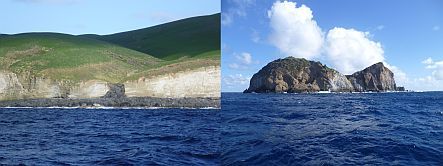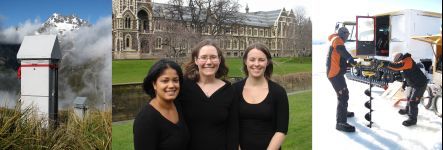Our Changing World for Thursday 4 August 2011
First Decade for Liggins, 90 years for Cawthron

The Liggins Institute's founding director Sir Peter Gluckman, at left, with Mont Liggins, who was the inspiration for the institute's research focus.
The University of Auckland’s Liggins Institute is named after the late Sir Graham Liggins, better known as Mont Liggins, who was one of the country’s most eminent medical scientists. His work led to a better understanding of labour and birth and dramatically improved survival rates for premature babies. He was the first to give women steroid injections during premature labour to stimulate the development of the baby’s lungs - a treatment which is now standard obstetric practice.
Founded in 2001, the institute has focused its research on pregnancy, birth and foetal development, gathering evidence for the importance of maternal diet as a determining factor for the long-term health of a baby, and how nutrition during critical stages of development, from before conception through to adolescence, affects the risk of middle-age diseases such as obesity, diabetes and coronary heart disease. Last week, scientists and staff gathered to celebrate the institute's 10th anniversary and Mont Liggins' ongoing legacy.
Meanwhile, the Cawthron Institute in Nelson marked its 90th anniversary this year. The Cawthron is New Zealand's largest independent not-for-profit research institute, bequeathed by Nelson philanthropist Thomas Cawthron. When he died in 1915 he left the residue of his estate for the establishment of an 'industrial, technical school institute and museum', to be named after him. The institute went on to pioneer research into insect and plant diseases, soil and plant nutrition and agricultural chemistry, before focusing its research on aquaculture and freshwater and marine ecosystems.
Kermadec Volcanic Arc – Kermadecs Series

Macauley Island (left) showing a lava flow surrounded by thick ash layers, and Cheeseman Island (right) (photos: A. Ballance)
If there is one thing that most people know about the Kermadec Islands, and Raoul Island in particular, is that they have a habit of erupting. To find out more about the very active Kermadec Volcanic Arc (as there were no volcanologists along on the Kermadecs Biodiscovery Expedition), Alison Ballance heads to GNS Science in Lower Hutt to talk with geologist Cornel de Ronde, who has been involved in a number of oceanographic research voyages surveying the little-known submarine volcanoes along the Arc. Cornel de Ronde was the winner of the 2010 Prime Minister’s Prize for Science Communication, and earlier this year led the expedition which rediscovered the Pink and White Terraces near Rotorua.
Persistent Organic Pollutants

From left to right: A high-volume sampler at Temple Basin, Arthur’s Pass; Ruma Ghosh, Kimberley Hageman, and Karen Lavin at the University of Otago; and Ruma Ghosh (on the right) drilling ice holes at McMurdo Sound (Image: Simon Morley)
Organic chemicals (like DDT, dioxins, and PCBs) which are toxic, persist in the environment, and bio-accumulate in food webs, are called persistent organic pollutants (or PoPs), and are the focus of University of Otago’s Kimberly Hageman research.
While PoPs vaporise and travel in the atmosphere, they are "semi-volatile" and condense back to the earth at cold temperatures, concentrating in places like New Zealand’s alpine regions, and the white expanses of Antarctica, which are generally considered pristine. For example, after a month of sampling, PhD student Karen Lavin found PoPs in Temple Basin at Arthur’s Pass, including endosulfan from Australia, and chlorpyrifos from the Canterbury Plains.
PhD student Ruma Ghosh has been studying the physiological responses of Antarctic fish, Trematomus bernacchii, to exposure to polybrominated diphenyl ethers (PBDEs). These PoPs are flame retardants and enter the water through sewerage systems at Antarctic bases. One of her findings was that fish exposed to PBDEs have reduced lipid abundance in the liver, which could potentially impact on the reproductive capacity of these fish.
Energetics of Wearing Medieval Armour

Federico Formenti attaching an oxygen consumption metabograph to a participant wearing medieval armour (left), who then walked and ran on a treadmill (Photos: Dr Graham Askew, University of Leeds)
Medieval armour and treadmills are two concepts that don’t usually sit in the same sentence - except when exercise physiologists and biomechanics researchers decide to quantify the ‘cost’ of wearing a suit of armour, which can weigh between 30 and 40 kilograms. Federico Formenti from the Department of Sport and Exercise Science at the University of Auckland tells Alison Ballance how he was part of an international team of researchers who put a number of men wearing suits of medieval armour through an exercise regime on a treadmill, and recorded oxygen consumption as a measure of the energetic cost involved. It turned out that it took twice as much energy to walk in a suit of armour, and the researchers speculate this may have affected the outcome of a number of historic battles, such as the Battle of Agincourt. The paper ‘Limitations imposed by wearing armour on medieval soldiers’ locomotor performance’ by Graham Askew, Federico Formenti and Alberto Minetti was published in the Proceedings of the Royal Society B.